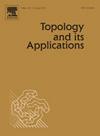正态性与n可分解拓扑群
IF 0.5
4区 数学
Q3 MATHEMATICS
引用次数: 0
摘要
由a . a . Markov的结果可知,每一个Tychonoff空间都可以作为闭子空间嵌入到一个Hausdorff拓扑群中,因此存在大量的非正规空间的Hausdorff拓扑群。我们如下介绍两类非常广泛的拓扑群(不一定是正规空间)。Hausdorff拓扑群G称为n可分解群。如果对于G上的每一个连续实值函数f,存在一个在法向上的连续同态π:G→H。对于H上的连续实值函数H,我们研究了n -可分解和pc -可分解拓扑群的类别,它们除了包含所有r -可分解和m -可分解拓扑群外,还分别包含所有正规拓扑群和所有副紧拓扑群。我们证明了每一个拓扑群都是一个pc可分解群的商。结果表明,n可分解群是Hausdorff拓扑群的一个适当子类,而pc可分解群是n可分解群的一个适当子类。后两类群在取完全同态象时是封闭的。然而,与正规空间相似,这两个类不是有限生产的,即使因子是ω-窄群。提出了几个悬而未决的问题。本文章由计算机程序翻译,如有差异,请以英文原文为准。
Normality and N-factorizable topological groups
By a result of A.A. Markov, every Tychonoff space is embeddable as a closed subspace into a Hausdorff topological group, so there is a wealth of Hausdorff topological groups that are not normal spaces. We introduce two very wide classes of topological groups (that are not necessarily normal spaces) as follows. A Hausdorff topological group G is called -factorizable (resp., -factorizable) if for every continuous real-valued function f on G, there exists a continuous homomorphism onto a normal (resp., paracompact) topological group H such that , for some continuous real-valued function h on H. We study the classes of -factorizable and -factorizable topological groups which contain all normal and, respectively, paracompact topological groups, in addition to all -factorizable and -factorizable topological groups. We show that every topological group is a quotient of a -factorizable group.
As it turns out, the -factorizable groups form a proper subclass of Hausdorff topological groups, whereas the -factorizable groups are a proper subclass of the -factorizable groups. The latter two classes of groups are closed when taking perfect homomorphic images. However, similar to normal spaces, the two classes are not finitely productive, even if the factors are ω-narrow groups. Several open problems are formulated.
求助全文
通过发布文献求助,成功后即可免费获取论文全文。
去求助
来源期刊
CiteScore
1.20
自引率
33.30%
发文量
251
审稿时长
6 months
期刊介绍:
Topology and its Applications is primarily concerned with publishing original research papers of moderate length. However, a limited number of carefully selected survey or expository papers are also included. The mathematical focus of the journal is that suggested by the title: Research in Topology. It is felt that it is inadvisable to attempt a definitive description of topology as understood for this journal. Certainly the subject includes the algebraic, general, geometric, and set-theoretic facets of topology as well as areas of interactions between topology and other mathematical disciplines, e.g. topological algebra, topological dynamics, functional analysis, category theory. Since the roles of various aspects of topology continue to change, the non-specific delineation of topics serves to reflect the current state of research in topology.
At regular intervals, the journal publishes a section entitled Open Problems in Topology, edited by J. van Mill and G.M. Reed. This is a status report on the 1100 problems listed in the book of the same name published by North-Holland in 1990, edited by van Mill and Reed.

 求助内容:
求助内容: 应助结果提醒方式:
应助结果提醒方式:


